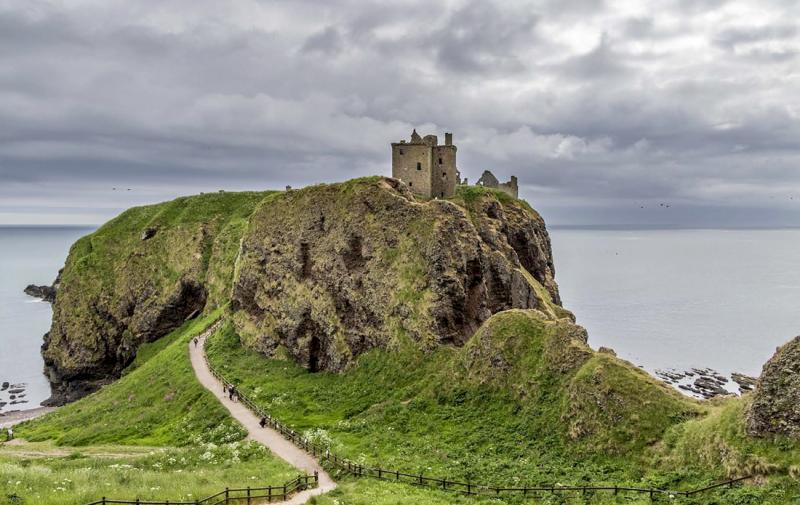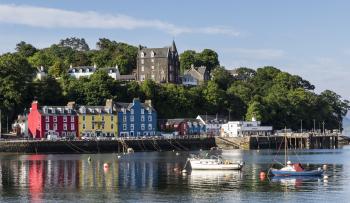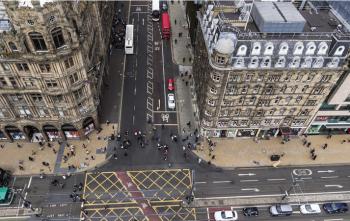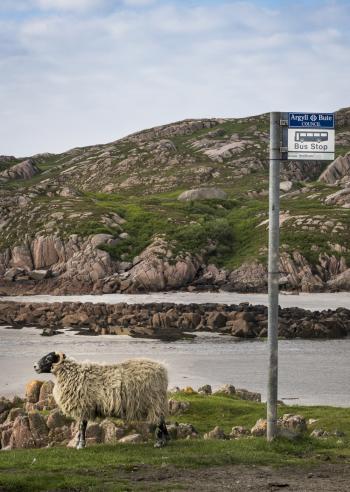Spectacular Scotland
This article appears on page 6 of the June 2019 issue.
My husband, Steve, and I have Felix Mendelssohn to thank for our June 2018 trip to the Scottish islands. Steve is an amateur musician and had yearned to visit Fingal’s Cave since hearing the German composer’s “The Hebrides” overture.
This interesting geological oddity is not easy to visit, requiring a ferry ride from mainland Scotland to the Isle of Mull, then a boat excursion to the uninhabited island of Staffa. To make it even more challenging, the trip is only offered from April to October and is dependent on fair weather.
As long as we were going to be visiting Mull, I decided to extend our trip to the Isle of Skye, the Orkney Islands and the Shetland Islands as well.
The plan
This was a trip where logistics were the trickiest part of the planning, our journey requiring we take multiple modes of transportation. Because the summer weather in Scotland is frequently stormy and foggy, ferries are more reliable during the warmer months, but flying is preferable in the winter. Then there is the ferry schedule to take into consideration, as the ferry to Orkney is not available every day.
After doing extensive research in guidebooks and online, I decided on a 14-day itinerary. We flew to Edinburgh from Atlanta with British Airways, using Avios points for business-class seats. The extra fees required in addition to miles were outrageous, but it still meant we got two business-class tickets for a total of $2,600.
In Edinburgh, we picked up an Enterprise rental car that we had reserved through Costco for $483. Knowing Steve would be driving on the left while I navigated, we splurged on an automatic. We used our American Express card to pay so that we would have full insurance coverage (for a $19 fee from AmEx).
Oban and beyond
On our first night, we stayed outside of Edinburgh in Linlithgow at the Star & Garter Hotel (1 High St.; starandgarterhotel.co.uk) for $97. The room was fine, but we had to climb several flights of stairs with our luggage to get to it. Scotland was experiencing what was, for them, a heat wave, so we were quite warm, even with the window open. This would be the case throughout our stay in Scotland, as rooms are not generally air-conditioned.
The next day we drove to Oban, sightseeing along the way, and caught the 4 p.m. ferry to the Isle of Mull. It was necessary to be at the ferry loading site no less than 30 minutes before our scheduled sailing, but I’d recommend being there an hour before, as that is when they start loading.
After landing, we drove to Tobermory, a small picturesque town on the water, where we stayed at the Western Isles Hotel (phone +44 [0] 1688 302012, westernisleshotel.com). This was a beautiful property in a stunning location on a cliff overlooking the harbor. (The cost was £140, or $183.) They had a lovely restaurant, where we ate dinner.
Our tour of Mull began the next day as Steve learned to drive on the island’s single-track roads. Frequent signs warned “Oncoming Vehicles in Middle of the Road.” Fortunately, there were frequent pullouts with room to pass, and Steve soon mastered the art of slowing down just enough so that either we or the oncoming car could pull over without anyone having to come to a full stop.
The sheep were another matter. Having not learned to use the passing places, they were prone to saunter down the middle of the road. At least the Highland cattle, with their long, curving horns and shaggy hairdos, were safely behind fences!
Fingal’s Cave
Since our Staffa tour boat was scheduled to leave at 9:30 the next morning, we spent the night on the other end of the island, right by the dock in Fionnphort. The Seaview B&B (phone +44 [0] 1681 700235, seaview-mull.co.uk), a charming place, cost us £105.
The morning dawned clear, and we had smooth passage to the famous island. When the boat landed, several dozen of us trooped up the stairs, heading for the cave we’d come to see.
The island is composed of nearly perfect hexagonal basalt columns, formed by cooling lava, and the area around the cave was devoid of vegetation (although the rest of the island had many patches of grassland and wildflowers). We had about an hour to explore the island.
Fingal’s Cave is composed of the basalt columns and looked to me rather like a giant, black pipe organ. The walk to the cave, over the basalt, was just a short distance from our landing site. The cave itself, however, had a sign warning that the path into the cave had been damaged by weather and should not be attempted. The sign was not enough, however, to discourage my intrepid husband and several others from entering the cave, while I stood outside to capture a photo of Steve as he emerged.
I had heard that the other end of the island had a colony of puffins, so I hiked along until I found the little creatures, which were captivating a number of onlookers. The birds seemed totally unfazed by the close proximity of their audience.
After catching the 4:00 ferry back to the mainland, we drove to Fort William, detouring to Glencoe on the way. The afternoon sun turned the valley walls golden, and I could see why this place has been painted and photographed so many times. We stayed the night at the Mansefield House (phone +44 [0] 1397 772262, fortwilliamaccommodation.com) in Fort William for $105.
Next on our itinerary was the Isle of Skye. Twenty years ago, the government built a bridge to this island. According to our host at the beautifully decorated Gleann an Ronnaich B&B in Portree (Staffin Rd., www.gleannanronnaichbandbskye.co.uk), where we stayed for £95, after seeing the resulting traffic pouring over the bridge from the mainland, other islanders refused to have any bridges built to their islands.
On Skye we visited Dunvegan Castle, sited on a promontory overlooking Loch Dunvegan. The castle is the home of Clan MacLeod and hosts a clan gathering every four years. The gardens were lovely, and there are boat trips to see seals if one is so inclined.
Back on the mainland the next day, we drove across the Scottish Highlands, stopping in Cairngorms National Park at the Fairwinds Hotel (Main St., Carr bridge; fairwindshotel.com)
Skye to Kirkwall
for £104. We were on our way to Aberdeen, where we would catch the ferry for Kirkwall, Orkney.
We had time the next day to visit Balmoral Castle, the Scottish holiday home of the royal family, as our ferry didn’t leave until 5 p.m. We were lucky enough to be at Balmoral for a bagpipe marching band concert.
The NorthLink Ferries system has a very easy-to-understand website (www.northlinkferries.co.uk), with options for different levels of comfort. The trip from Aberdeen to Kirkwall would take six hours, with arrival at 11 p.m., so I booked a reclining seat and dinner for two, with drinks, in Magnus’ Lounge for £216. This included the charge for our rental car, which we took with us to the outer islands.
When we found our reserved seats on the ferry, we were dismayed to see that they were right in front of a communal television set. However, when I asked a steward, I learned that we could choose any seat that didn’t have a “Reserved” sign, so we found a comfortable, quiet area of the ship in which to settle down.
We also spent a good part of the trip in Magnus’ Lounge; our meal was only so-so, but the dessert was excellent. We each were given two drink coupons, which were more than we needed.
Disembarking in Kirkwall, we had but a short drive to our hotel, the St. Ola Hotel. I would not recommend this hotel. Besides offering a very basic, rather ugly room for £105, it was excruciatingly noisy. On that Saturday night, the bar downstairs was in full swing, with very loud music. I used both earplugs and noise-canceling headphones and still struggled for over an hour to get to sleep.
Ancient sites
In spite of the bad experience at the St. Ola, the visit to Orkney was definitely worthwhile. The island is the site of many impressive examples of prehistoric construction, including the Standing Stones of Stenness, Maeshowe and Skara Brae.
The Standing Stones, which are easily accessible, are considered to be one of the oldest henge sites in Britain. Across the road from the main site are a few individual standing stones with sheep grazing around them.
Maeshowe is a Neolithic burial chamber with Viking graffiti, which can be visited only with a tour guide, who shines a light on the graffiti while interpreting it for you.
The most impressive site was Skara Brae, a Neolithic settlement of eight stone houses thought to be occupied from 3180 BC to around 2500 BC. Older than the pyramids or Stonehenge, the site has a path to it that is lined with stone date markers, the distance between them proportional to the passage of time represented. The considerable distance between the marker for the pyramids and the site of these Neolithic stone homes emphasized how ancient this site really is.
The remarkable thing about these dwellings is they contain stone-built furniture. There are tables, beds, seats and storage boxes. I also was struck by how similar the construction was to buildings of even 100 years ago. According to archaeologists, the inhabitants kept sheep and cattle and raised barley; they also took advantage of the abundant fishing.
The sea giveth and the sea taketh away. In 1850 a storm battered Orkney, accompanied by winds and an unusually high tide, uncovering the remains of several stone houses, later excavated by the laird who owned the land. Then work on the site was abandoned. In 1925 another storm damaged the buildings, so a seawall was built to try to preserve them. Its construction uncovered even more dwellings.
Today, rising sea levels are again threatening not only Skara Brae but many other Neolithic sites on Orkney. According to Scottish archaeologists, the current erosion is considerably worse than at any time in the last 100 years.
There are many other sites being excavated on the island, and I wish we’d spent another day there. Instead, we took an 11:45 overnight ferry from Kirkwall to Lerwick, Shetland Islands. I had booked a premium, outside 2-berth cabin, which included access to Magnus’ Lounge for a bite to eat the next morning. Including passage for the car, the cost was £250. The accommodations were comfortable, and the North Sea was pleasantly calm.
On the lookout
We had two full days in the Shetlands but only needed one night’s lodging because our ferry arrived at 7 a.m. and departed at 5:30 the next evening. It was difficult to find lodging for only one night; most places required two. I finally found a room at the Eddlewood Guest House in Lerwick (8 Clairmont Place) for $132. We drove there as soon as we disembarked, and we left our luggage with the proprietor, who gave me the key and a passcode for the front door. When we returned, our luggage was in our room, but we never saw the man again.
A woman served breakfast the next morning, and that was all we saw of our hosts. The room was ok, but the sheer curtains did nothing to keep out the sun, which rose at 3:30!
The Shetland Islands are a birder’s paradise. By corresponding online (info@shetlandphototours.co.uk), I had hired a photography guide, Richard Shucksmith, for $250 per day. I was particularly interested in photographing otters.
Richard led us through an area of bogs, showing us exactly where to step to avoid sinking up to our waists! Finally, on our way back, he spotted several otters in the water, and we hunkered down behind rocks so they wouldn’t see us. I had not realized they were so elusive.
My longest lens was 400mm, but I still got a few good shots.
Richard couldn’t make it the next day, but he encouraged us to go to the Isle of Noss on our own. I am so glad he did. What a treat!
Noss is a National Nature Reserve off the coast of the Isle of Bressay. From Lerwick, we took a short car ferry ride to Bressay, then drove to the embarkation point for Noss. Between May and August, a ranger in a small, 6-seater boat shuttles visitors across Noss Sound, weather permitting. (The shuttle runs from 10 a.m. to 5 p.m. every day except Mondays and Thursdays.)
Once on the island, visitors can take a hiking trail that circumnavigates the island. It’s best to walk counter clockwise; the most breathtaking cliffs come into view about halfway around the island.
Seabirds were nesting in the cliffs; thousands of gannets swooped from the cliffs to the sea, spearing fish; fulmars nested among the rocks and wildflowers, and puffins dotted the hillside, unaffected by our human presence. We saw only a handful of other people during our time on the island.
Note: There are no amenities in the park. The small ranger station houses a toilet, but it is necessary to take any needed water or food with you to the island. The hike takes about three hours, but it’s easy to spend a full day there admiring and photographing the landscape and the wildlife.
The Shetland Islands were easily my favorite area of Scotland.
The last boat left Noss for Bressay at 5 p.m., but we had to leave earlier, as we had the overnight ferry to catch from Lerwick back to Aberdeen. Once again, we ate in the dining room and had a pleasant night’s sleep in our cabin. The fare, with car, dinner, drinks and cabin, was £344.
We arrived at Aberdeen at 7 a.m. With such an early arrival, we had all day to drive the approximately 140 miles from Aberdeen to Edinburgh, so we decided to take the coastal route, stopping at a few places along the way. My favorite was Dunnottar Castle, outside Stonehaven.
Dunnottar was what I was expecting a castle to look like. Situated high among the cliffs on a spit of land overlooking the sea, the castle ruins looked to be impervious.
A rather long walk from the car park, including almost 200 steps, led us down, then back up to the entrance. The view is worth a stop, even if you don’t go all the way down the walk to the ruined castle itself.
Ending in Edinburgh
We spent our last three nights of the trip in Edinburgh at the Murrayfield Hotel & House (18 Corstorphine Rd.; themurrayfield hotel.co.uk). These were the nicest accommodations we had on our trip, costing a total of £370.50 for the three nights, and we were only half a block from the bus line into the city.
There was a lovely restaurant on the premises as well, and because I had booked on their website rather than through an agent such as Hotels.com, a bottle of prosecco was waiting for us in our room.
We were in the main house. It looked as if the annex rooms were not as elegant.
Before we left home, we had read that the Orkney and Shetland islands were quite windy, but we had calm though cloudy weather while we were there. However, on our next-to-last day in Edinburgh, the wind was gale force. We had timed tickets to visit Edinburgh Castle, but when we arrived, they informed us the castle was closed due to the wind.
Fortunately, the impressive National Museum of Scotland was only a short distance away, and we spent the day there admiring the exhibits.
The next day was much calmer and we, along with thousands of other visitors, returned to the castle. Frankly, it was so very crowded that we left after a short time. Long lines snaked from every exhibit, which mostly had to do with prison or war.
The difference between that experience and the beauty and solitude of Noss was striking. It was, however, a good opportunity to get a panoramic view of the city.
Instead of continuing to wade through the crowds, we walked over to the Gothic monument to Sir Walter Scott and climbed the 287 steps to the top for a bird’s-eye view of the city. We had the place to ourselves.
One final adventure
We returned our car to the Enterprise lot at 5:30 the next morning and flew home that day.
When we were returning the car to the airport, we missed the turnoff and had to drive through the Arrivals and Departures lanes to loop back around. We could not exit those lanes and proceed to the car rental area without paying £1 at the automated exit gate! I had only a few pence in change, so I had to go to the car behind us and beg a £1 coin from the driver — very embarrassing, but we had never encountered an airport where you had to pay to leave.
Upon arrival at home, we found a message from the car rental company asking us when we planned to return the car! I stayed up until 1 a.m. so that I could talk to someone when they opened at 6 a.m. in Scotland. I explained that we had left the car in the Enterprise return lane and put the keys in the drop box. They couldn’t find the car! As of the next day, they still hadn’t found it.
Whenever we return a car after hours, I always take dated photos to show there is no damage. Fortunately, one of my photos, time-stamped at 5:32 a.m., clearly showed the car’s license plate as well as the Enterprise sign. I emailed that photo, and the next day I received my paid invoice.
I have no idea what happened to the car, but I was very thankful I had proof of delivery.
The northern Scottish islands are a rich treasure of scenic landscapes, prehistoric artifacts and wildlife. It took some planning and travel to get there, but the adventure was worth it.





